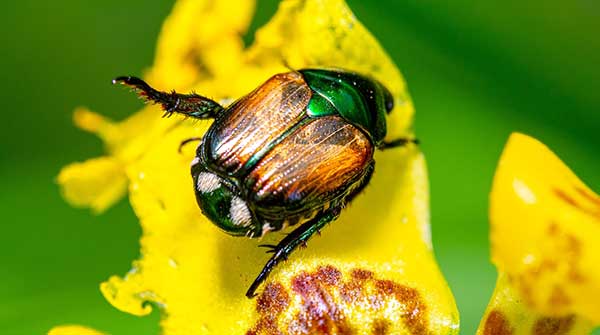Why else does hardly anything seem to want to eat Japanese Beetles?
 Lip-smacking good – crickets, earthworms, caterpillars, even some bees and wasps – yummy if you’re an insectivore that is! That’s what they call a creature that eats bugs.
Lip-smacking good – crickets, earthworms, caterpillars, even some bees and wasps – yummy if you’re an insectivore that is! That’s what they call a creature that eats bugs.
I spend a lot of time looking at stuff. Sometimes I understand what it’s doing, and sometimes I don’t. Last summer, I was plagued by Japanese Beetles that feast on every plant I love (and, for some reason, they avoid those plants I dislike).
I was thinking that with the worldwide decline in insects, why does it seem that hardly anything eats these beetles? Could it be that they taste bad? Or is there something else at play with Japanese Beetles?
We have all heard that some insects are brightly coloured to warn predators that they taste bad – the Monarch Butterfly does that. But is that the case with these beetles?
 Photo by Oktavianus Mulyadi |
| Related Stories |
| Would you eat chicken raised on a diet of insects?
|
| The Japanese Beatle is attractive, but can be annoying
|
| Who doesn’t want to eat a meadow vole?
|
The Japanese Beetle first appeared in North America in the early 1900s and has devastated crops and gardens ever since. In this species, the immature (larval) stage is very different than the adult stage. In fact, the larvae look very much like White Grubs and act much the same, spending most of their time in the soil. They are juicy and nutritious, so a lot of things – for example, moles, raccoons and skunks – eat them as they are abundant in our lawns. So it seems that at least the larval stage is palatable.
The adults are different – a hard carapace (outer shell or exoskeleton) makes them crunchy and perhaps hard to break open to get at the juicy innards. But it seems that many predators can and do eat them.
So why are they still doing so well? The answer lies in several factors. They are prolific breeders and exude a pheromone to make sure that they can find each other when populations are spread out. They breed quickly and have lots of young which live in the soil, going deeper as the season progresses so predators have trouble finding them. The adults feed on many species of our native plants, so finding dinner is never a problem. Finally, there are few naturalized predators here, so even if an individual bird or mammal finds them edible, other predators may not have figured that out yet.
I watched an Eastern Phoebe (a small flycatcher) recently. Right beside it, on a Trumpet Vine, about 30 Japanese Beetles were buzzing around in a sexual and feeding frenzy (yes, I watched the whole thing, LOL). The Phoebe ignored them and repeatedly flew to the ground to catch other small insects.
Were these insects softer and easier to catch and digest? Perhaps. So it seems that the beetles don’t really taste bad; they are just in a new environment where the natural controls are not yet established.
Nature is resilient, and she will figure things out. It takes time, but predators do adapt and, over time, can have a controlling influence. Diseases may morph and also eventually impact these beetles.
One hopeful sign for the control of Japanese Beetles is the presence of tachinid flies, which parasitize many caterpillars, sawfly larvae, beetle larvae, earwigs, grasshoppers and many more insects – and best of all, they parasitize Japanese Beetle adults!
Tachinid flies have several intriguing egg-laying strategies. In some species, eggs are laid on foliage near a host insect; the eggs hatch and the maggots are consumed by the host insect when it feeds on the foliage; then the maggots feed on and develop in the host insect, killing it. In other species, tachinid females have long ovipositors that they use to pierce the skin of the host insect and insert their eggs in its body.
In yet other species (the Winsome Fly), the adult tachinid glues her eggs somewhere on the outside body of the host, the eggs hatch, and the maggots penetrate the host’s body. This is the most common strategy we see for tachinids that attack Japanese Beetle adults – so there is still hope!
Geoff Carpentier is a published author, expedition guide and environmental consultant.
For interview requests, click here.
The opinions expressed by our columnists and contributors are theirs alone and do not inherently or expressly reflect the views of our publication.
© Troy Media
Troy Media is an editorial content provider to media outlets and its own hosted community news outlets across Canada.

